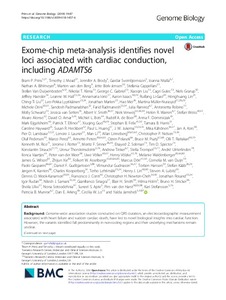Exome-chip meta-analysis identifies novel loci associated with cardiac conduction, including ADAMTS6
Alonso A; Launer LJ; Klena NT; Psaty BM; Rice KM; de Boer RA; Dorr M; Jamshidi Y; Verweij N; Bork-Jensen J; van Duijn CM; Volzke H; Lambiase PD; Pedersen O; Xie ZJ; Smith BH; Sotoodehnia N; Padmanabhan S; Weiss S; Gudbjartsson DF; Mook-Kanamori DO; Strauch K; Radmanesh F; Stricker BH; Warren HR; Thorsteinsdottir U; Polasek O; Sinagra G; Felix SB; Gulec C; Munroe PB; Ntalla I; Rotter JI; Ulivi S; Isaacs A; Robino A; Bots ML; Apte SS; Lubitz SA; Hall LM; Kahonen M; Li M; Rosand J; Arking DE; Dominiczak AF; Muller-Nurasyid M; Waldenberger M; Schwartz M; Rudan I; Cappellani S; Jukema JW; Spector TD; Iorio A; Trompet S; Stefansson K; Mead TJ; Newton-Cheh CH; Prins BP; Smith AV; Bihlmeyer NA; van der Harst P; Conti FJ; Eijgelsheim M; Sinner MF; Liu XQ; Gudnason V; Mei H; Peters A; Ellinor PT; Kors JA; Perez M; Lyytikainen LP; Lehtimaki T; Kaab S; Vaartjes I; Raitakari OT; Kanters JK; Gabriel GC; Guo XQ; Soliman EZ; Grarup N; Li-Gao RF; Kooperberg C; Lin HJ; Haessler J; Holm H; Nelson CP; Volker U; Tinker A; Lin HH; Uitterlinden A; Harris TB; Arnar DO; Heckbert SR; van den Berg M; van Setten J; Asselbergs FW; Marten J; Hansen T; Gasparini P; Van Duijvenboden S; Ramirez J; Hayward C; Samani NJ; Wilson JG; Sveinbjornsson G; Brody JA; van der Meer P; Linneberg A; Huang PL; Lo CW; Orini M; Liu CT
Exome-chip meta-analysis identifies novel loci associated with cardiac conduction, including ADAMTS6
Alonso A
Launer LJ
Klena NT
Psaty BM
Rice KM
de Boer RA
Dorr M
Jamshidi Y
Verweij N
Bork-Jensen J
van Duijn CM
Volzke H
Lambiase PD
Pedersen O
Xie ZJ
Smith BH
Sotoodehnia N
Padmanabhan S
Weiss S
Gudbjartsson DF
Mook-Kanamori DO
Strauch K
Radmanesh F
Stricker BH
Warren HR
Thorsteinsdottir U
Polasek O
Sinagra G
Felix SB
Gulec C
Munroe PB
Ntalla I
Rotter JI
Ulivi S
Isaacs A
Robino A
Bots ML
Apte SS
Lubitz SA
Hall LM
Kahonen M
Li M
Rosand J
Arking DE
Dominiczak AF
Muller-Nurasyid M
Waldenberger M
Schwartz M
Rudan I
Cappellani S
Jukema JW
Spector TD
Iorio A
Trompet S
Stefansson K
Mead TJ
Newton-Cheh CH
Prins BP
Smith AV
Bihlmeyer NA
van der Harst P
Conti FJ
Eijgelsheim M
Sinner MF
Liu XQ
Gudnason V
Mei H
Peters A
Ellinor PT
Kors JA
Perez M
Lyytikainen LP
Lehtimaki T
Kaab S
Vaartjes I
Raitakari OT
Kanters JK
Gabriel GC
Guo XQ
Soliman EZ
Grarup N
Li-Gao RF
Kooperberg C
Lin HJ
Haessler J
Holm H
Nelson CP
Volker U
Tinker A
Lin HH
Uitterlinden A
Harris TB
Arnar DO
Heckbert SR
van den Berg M
van Setten J
Asselbergs FW
Marten J
Hansen T
Gasparini P
Van Duijvenboden S
Ramirez J
Hayward C
Samani NJ
Wilson JG
Sveinbjornsson G
Brody JA
van der Meer P
Linneberg A
Huang PL
Lo CW
Orini M
Liu CT
BMC
Julkaisun pysyvä osoite on:
https://urn.fi/URN:NBN:fi-fe2021042719785
https://urn.fi/URN:NBN:fi-fe2021042719785
Tiivistelmä
Background: Genome-wide association studies conducted on QRS duration, an electrocardiographic measurement associated with heart failure and sudden cardiac death, have led to novel biological insights into cardiac function. However, the variants identified fall predominantly in non-coding regions and their underlying mechanisms remain unclear.Results: Here, we identify putative functional coding variation associated with changes in the QRS interval duration by combining Illumina HumanExome BeadChip genotype data from 77,898 participants of European ancestry and 7695 of African descent in our discovery cohort, followed by replication in 111,874 individuals of European ancestry from the UK Biobank and deCODE cohorts. We identify ten novel loci, seven within coding regions, including ADAMTS6, significantly associated with QRS duration in gene-based analyses. ADAMTS6 encodes a secreted metalloprotease of currently unknown function. In vitro validation analysis shows that the QRS-associated variants lead to impaired ADAMTS6 secretion and loss-of function analysis in mice demonstrates a previously unappreciated role for ADAMTS6 in connexin 43 gap junction expression, which is essential for myocardial conduction.Conclusions: Our approach identifies novel coding and non-coding variants underlying ventricular depolarization and provides a possible mechanism for the ADAMTS6-associated conduction changes.
Kokoelmat
- Rinnakkaistallenteet [19250]
